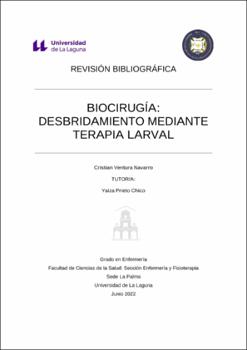Biocirugía: desbridamiento mediante terapia larval
Fecha
2022Resumen
La llamada terapia larval o biocirugía es una técnica que consiste en la
aplicación de larvas estériles (especies como por ejemplo: Lucilia Sericata) en
focos infecciosos de heridas crónicas para su desinfección, eliminación de olor
y desbridamiento, con el objetivo de poder restaurar el tejido afectado.
Los buenos resultados obtenidos en el proceso (eficacia y velocidad) han hecho
de esta terapia una alternativa viable para la cura de diferentes tipos de heridas
como; quemaduras, pie diabético, abscesos y distintos tipos de úlceras, ya sean
venosos o crónicos. No obstante, debido a la controversia que genera el tema,
hoy en día, es utilizado como terapia alternativa a los tratamientos
convencionales en la mayoría de países, como España, en la que se ha aplicado
en contadas ocasiones.
La presente revisión bibliográfica pretende analizar los actuales artículos para
así conocer mejor una terapia de la que se desconoce mucho y que ha
demostrado no solo ser eficaz, sino además tener apenas efectos secundarios
durante el proceso de reparación tisular, consiguiendo incluso reducir el
porcentaje de amputaciones en miembros, y en consecuencia, una mejor
calidad de vida del paciente.
Al ser las enfermeras las máximas responsables en la cura de heridas, debemos
dar a conocer este tipo de terapia dentro del sector sanitario de nuestro país y
tenerlo en cuenta como un tratamiento más en la curación de heridas. The so-called larval therapy or biosurgery is a technique that consists in the
application of sterile larvae (species such as: Lucilia Sericata) in infectious foci of
chronic wounds for disinfection, elimination of odor and debridement, with the aim
of restoring the affected tissue.
The good results obtained in the process (efficacy and speed) have made this
therapy a viable alternative for the healing of different types of wounds such as
burns, diabetic foot, abscesses and different types of ulcers, whether venous or
chronic. However, due to the controversy generated by the subject, nowadays, it
is used as an alternative therapy to conventional treatments in most countries,
such as Spain, where it has been applied in a few occasions.
The present bibliographic review aims to analyze the current articles in order to
learn more about a therapy that is largely unknown and that has been shown not
only to be effective, but also to have few side effects during the tissue repair
process, even managing to reduce the percentage of amputations in limbs, and
consequently, a better quality of life for the patient.
As nurses are the most responsible in wound healing, we must make this type of
therapy known within the health sector of our country and take it into account as
another treatment in wound healing.





